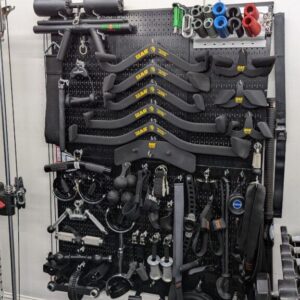How Kids Should Be Lifting Weights
Last month, we focused on Should Kids Lift Weights?. The resounding answer to that question was YES! But as parents, we want the best for our kids and want to make sure to keep them safe, and that means inside the gym as well! The gym can be a scary place. There’s so much that goes into lifting properly, learning new equipment, and structuring a workout program. It’s hard enough learning how to do all these things correctly and efficiently for yourself. Then it’s a whole different ball game when it comes to children. Because of this, today we are going to direct our focus into How Kids Should Be Lifting Weights.
Table of Contents
Key Notes
Yes, kids should be lifting weights. But doing it correctly is important for a number of reasons. Focus on their long term enjoyment and development, instead of immediate progress.
Transparency Note
Some of the items and links in this article might be affiliate links, or might be linked to a Sponsor of the Garage Gym Competition. These links and sponsorships help fund the website, the competition itself, the newsletter, non-profit donations, and everything else we do FOR FREE here at the GGC. I like to be transparent so you know what is up. I appreciate the support if you choose to use the links.

It Starts With YOU
Like we stated in our previous article, children are already doing scaled versions of most of the movements that we train in the gym. The problem is that most people become sedentary after adolescence, which means their movement quality in and out of the gym diminishes as they move into adulthood. This is why so many people struggle with the same basic movements that your kids do daily like push, pull, squat, hinge, and rotational movement.
But kids don’t regress in these areas if we keep them consistently active. The gym is a fantastic place for kids to start and continue to progress these movements throughout their entire life. They can begin building this habit as soon as they can sit and watch you, way before they can pick anything up themselves.
As they progress (which typically means adding weight in some form), proper technique and form in exercise becomes a key factor in keeping them healthy. Staying healthy means maintaining those healthy habits.
They will learn their consistent habits and their form from YOU. Everything a kid does is from watching and learning, so it’s very important that you are regularly making time for the gym and doing exercises correctly.
This is the time in our own lives where we have to set aside our egos, lower the weight, and ensure that each rep is performed correctly while our kids watch. They’ll begin to mimic every movement you do. So do it right, so they can too! So the first step in How Kids Should Be Lifting… is watching you be consistent and doing it correctly!

When Should Kids Start Lifting
You can invite your kid into the gym as soon as they are born. They can pick up ideas and take in information about your habits and lifting simply by watching. They can start doing bodyweight movements once they start moving around and continue to do these for the first several years of their life. This will help with coordination, confidence, and help YOU gain some early coaching experience.
If we read our first article, we already know this. We are focusing today on How Kids Should Be Lifting… key word is lifting. It isn’t until a kid starts gaining coordination in their movement in which we can actually start introducing equipment into their routine. Bars, dumbbells, kettlebells, and other weighted movements require stability and balance that kids often lack. Without these, it can be dangerous for them to lift much more than a PVC pipe for things like deadlifts and bench press. Until then, focus on bodyweight activities that still fit our foundational movements.
How Do We Know If They Are Ready?
Kids will hit these coordination milestones at different ages. Let’s take these two pictures for example. The kid in the top photo is struggling to hold small dumbbells. You can tell the kid in the bottom photo has the coordination to hold a barbell in an athletic stance. These two children are fairly similar in age, but are at very different levels of coordination and readiness for lifting.
Each kid is going to be different, and that is why your best approach is to get them into the gym early, and gradually test their abilities. Watch as they begin to pick things up off the ground, hang from bars, play at the park, or try and mimic your movements in the gym. If you have a broomstick or PVC pipe available, watch them move with it, bench with it, squat with it. Encourage them to mirror your activities and watch their confidence and coordination grow without having to be concerned about them hurting themselves.
When they start to gain control, show signs of strength and stability, this is when you can start to introduce more equipment that has some weight to it. Kids bars, small kettle bells, you name it.
If your kid starts playing organized sports, you’ll likely notice that this is fairly close to the same time they start to develop that requisite coordination. Their bodies are taking in information at an exponential rate to play these organized sports. They can benefit from pairing these sports with weighted exercise to promote strength, balance, coordination, speed, power, and even injury prevention.
So step two for How Kids Should Be Lifting, is all about you as the parent paying attention to their physical development and introducing the right tools and equipment at the right times.


Proper Form First
When they begin lifting weights with equipment, we want them to be using proper form. As we noted, if they have been watching you with proper form, a lot of the heavy lifting (pun intended) will be taken care of. You’ll begin giving them VERY light loads on barbells, dumbbells, and other equipment so we can begin resistance training, but continue those good biomechanical patterns.
It’s best to stick to very simple movements while they’re working on strength. Movements like strict pressing (overhead or bench), rows, back squats, and deadlifts. They aren’t training to be powerlifters at this age (even if they compete in the Garage Gym Competition). These are simple enough movements to do under load and gain strength without putting them at any necessary risk. And remember, these are movements they have done for years in a bodyweight fashion, have hopefully watched you do as well, and now it is time for them to tip toe into it as well.

As they start gaining a good base of strength, you can start throwing in additional exercises. Make sure you yourself are comfortable with the movements so you can demonstrate anything you want them to do. And make sure you can coach the movements as well. Items like Olympic lifts can do wonders for mobility, strength, power, and more. Doing movements like curls, cable pressdowns, and other typical “accessory” work can help build muscle, introduce them to new movements patterns, and more. But that is only when they are done correctly.
Step three for How Kids Should Be Lifting is about focusing on form before anything else. You yourself need to know the ins and outs of exercises before putting your kid through anything. Again, this is why the basics and fundamentals are often the best route.

Movements Don’t Equal Programming
So we know that kids SHOULD be in the gym. We know that they should start with bodyweight fundamental movements and then add equipment and exercises as they gain coordination and strength. But you need to know what to do with all of that once they are ready to do so. The good news is, the beginnings are fairly simple. And no, you don’t need to be a programming wizard like Chad Wesley Smith of Juggernaut to make this work.
When your kids are really young, focus on creating a fun and welcoming environment for them in the gym. You don’t need a training program for a 4 year old. You need them to get in, watch, be active, and have fun in the gym. If they want to deadlift, do it. If they want to squat, do it. They can carry stuff, jump on things, climb around, whatever. Encourage fun activity IN THE GYM. They should keep the reps low, the intensity low, and focus on form.
This isn’t the time for pushing to extreme one rep maxes, hitting AMRAPS, or getting a huge pump. Add weight as the form allows, and add reps as the form allows. And make sure they are learning the rules of the gym. Where to sit, where to stand, when to talk, how to spot, you name it. Your kid should be learning what being in the gym looks like in every way.

Actual Program
As they get older, an actual program can start to form. Fit this in around sports, school, and activities. A couple days a week is more than enough to supplement what is hopefully an already active childhood. Ideally have your kids mirror your workouts. If you are squatting, they can squat. If you are deadlifting, they can deadlift. Your kid can do deadlifts, pull-ups, rows, and planks. They can do squats, leg extensions, sled work, and medicine ball throws. As long as you can scale the exercise to them, you know how to coach it, they can do the same workout as you. The basic movements are the best, but don’t discourage them from trying something new.
How Kids Should Be Lifting with regards to programming is easy. Focus first on fun. Then focus on high quality movement. Then worry about a structured program from there. Proper programming for an adult, is proper programming for a kid (in the simplest of forms).
Wrap Up
If you are here and unsure of what to do, my recommendation is to work with someone locally who does. Get a coach, find someone who can help you help your kid. The intent here was not to scare you from coaching your own kid, but also… you shouldn’t just jump in without knowing what you are doing. Be realistic with yourself for the sake of your kid.
I hope you all have been enjoying this series so far. Each article is going to dive a little bit deeper on a topic involving kid’s fitness. It is knowledge intended for the average fitness go-er/parent. So, if you have any specific questions regarding one of these topics or want to dive into them further, you can find me on social media. Next month we will be diving into the topic of how we make working out an activity for the entire family and how to have fun doing it! Make sure you keep tuning in to each one of these articles, there will be some good tips for everyone, parents or not!

About The Article Series
Jeff Kimpel is the owner and host of the Primal Armor podcast where he takes his education and experience and dives deep, but succinctly, into a topic to help you be a better version of yourself. With the birth of his daughter, Jeff has reinvigorated his passion for getting kids active and involved in exercise. His Masters Thesis involved kid’s fitness and sports!
Our aim is to help you get your kids into the gym. Because strong families lift TOGETHER!
You can find more on the podcast here.
📌Enjoy Powerlifting? Want to enter a FREE competition with thousands of dollars in prizes and donations to non-profits? Check out our next event!
🏅 Own a home gym? Like to save money? Check out my full list of discount codes.



